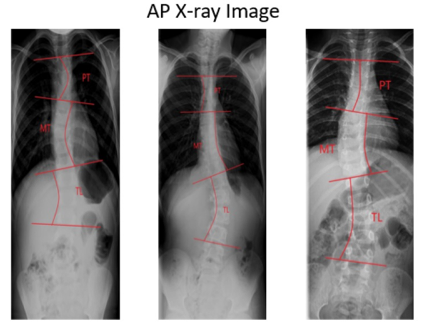Accurate Automated Spinal Curvature Estimation¶
MICCAI 2019 Challenge¶
Important Notes¶
- Participants can form teams now. The team will be treated as a unit. Finally, we will leave the result of the highest score by default. Team formation must be completed by September 9, 2019.
- All participants are required to submit a challenge paper. Only those submitted papers to the challenge will be official participants. We will not evaluate submissions of teams not submitted the paper.
Winners of AASCE Challenge 2019¶
First Place:
Seg4Reg Networks for Automated Spinal Curvature Estimation
Yi Lin, Hong-Yu Zhou, Kai Ma, Xin Yang and Yefeng Zheng (Tencent YouTu
Lab)
Second Place:
Accurate Automated Keypoint Detections for Spinal Curvature
Estimation
Kailin Chen, Cheng Peng, Yi Li, Dalong Cheng and Si Wei (iFLYTEK
Research South China, Computer Vision Group)
Third Place:
Automated Estimation of the Spinal Curvature via Spine Centerline
Extraction with Ensembles of Cascaded Neural Networks
Florian Dubost, Benjamin Collery, Antonin Renaudier, Axel Roc, Nicolas
Posocco, Gerda Bortsova, Wiro Niessen, Marleen de Bruijne (Erasmus MC;
Ecole des Mines de Saint-Etienne; Ecole Centrale de Marseille)
Important Dates¶
(may change according to the schedule of CSI2019)
- Training data release: Available on the SpineWeb
- Test data release: July 8, 2019
- Submission deadline:
Aug 20, 2019Sep 15, 2019 (11:59PM PST) - Paper submission deadline: **
Aug 20, 2019Sep 25, 2019 (11:59PM PST)** - All submissions will close at 11:59 PM PST.
Call for Participant¶
Accurate automated quantitative estimation of spinal curvature is an important task for the clinical evaluation and treatment planning of Adolescent Idiopathic Scoliosis (AIS). It solves the disadvantage of manual Cobb angle measurement (time-consuming and unreliable) which is the current clinical standard for AIS assessment. A couple of attempts have been made for automated Cobb angle estimation on single-view x-rays. However, it is very challenging to achieve a highly accurate automated estimation of Cobb angles because it is difficult to utilize the information of x-rays efficiently. This, in turn, has sparked specific interest in developing methods for accurate automated spinal curvature estimation and error correction in spinal anterior-posterior x-ray images.[1][2][3][4]
The goal of MICCAI 2019 Challenge on accurate automated spinal curvature estimation and error correction from x-ray images is to investigate (semi-)automatic spinal curvature estimation algorithms and provide a standard evaluation framework with a set of x-ray images. The challenge participating teams (two co-authors in each participating team) will be invited to contribute to a joint journal paper describing and summarizing the challenge outcome, which will be submitted to a high-impact journal in the field. This Challenge is in conjunction and with the support of the 2019 MICCAI Workshop on Computational Methods and Clinical Applications for Spine Imaging.

[1] Wu, H. , Bailey, C. , Rasoulinejad, P. , & Li, S.. Automatic Landmark Estimation for Adolescent Idiopathic Scoliosis Assessment Using BoostNet. MICCAI 2017.
[2] Wang, Liansheng, Qiuhao Xu, Stephanie Leung, Jonathan Chung, Bo Chen, and Shuo Li. "Accurate Automated Cobb Angles Estimation using Multi-View Extrapolation Net." Medical Image Analysis (2019), Volume 58: 101542.
[3] Chen, Bo, Qiuhao Xu, Liansheng Wang, Stephanie Leung, Jonathan Chung, and Shuo Li. "An Automated and Accurate Spine Curve Analysis System." IEEE Access (2019).
[4] Wu H, Bailey C, Rasoulinejad P, Li S. Automated comprehensive Adolescent Idiopathic Scoliosis assessment using MVC-Net. Medical image analysis. 2018 Aug 1;48:1-1.
